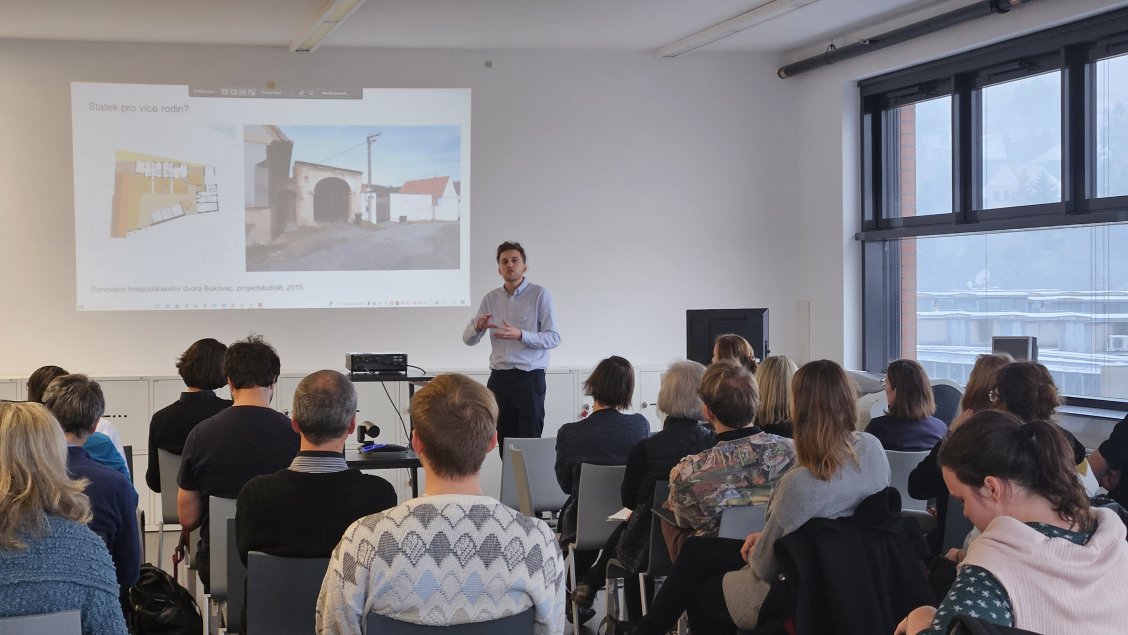How many rural areas do we have? And how should we approach them? The Rural Architecture conference was held at the FA
10/1/2024

A significant part of the programme consisted of presentations by doctoral students of the Faculty of Architecture of CTU, who had the opportunity to present their research to a number of experts. In addition to guests from the National Heritage Institute and other universities, the event was attended by representatives of the Institute of Ethnology and the Institute of Art History of the Academy of Sciences. The audience also included specialist craftsmen or active citizens and representatives of various associations.
The programme opened with a lecture by Radim Perlín (Department of Social Geography and Regional Development, Faculty of Science, Charles University). His contribution focused on demographic development in individual regions and opened the topic of several rural areas, i.e. the very different perspective of rural areas in the hinterland of large cities compared to localities in the borderlands or the so-called inner peripheries.
Dominika Výšková deals with the transformation of traditional house cladding in the Kraslice region. Therefore, she presented her ongoing research, the aim of which is not only to document the visual changes, but also to measure the parameters of the internal environment of the houses that are affected by modern interventions. However, traditional rural buildings can also be an inspiration for soft densification of suburbs (contribution by Jana Nádravská), and the design of blue-green infrastructure in the rural environment also requires its own specifics (prepared by Tereza Havránková).
Public and grant attention is also focused on ensuring a good quality of life for the elderly in rural areas. For those in rural areas who have been used to large buildings all their lives and need to be constantly cared for, the transition to an institutionalised facility can be even more difficult than for their urban peers. Matyáš Gál presented his research, based on interviews with residents of a number of community homes for the elderly. He drew attention to seemingly minor shortcomings that can lead to a loss of intimacy for seniors or prevent them from remaining active. The audience lively discussed the possibilities of gardening or the lack of space for storing personal belongings.
The National Heritage Institute was also significantly represented. Martin Čerňanský presented his home institution as a participant in the preparation of a number of land-use plans for heritage villages. At least in these areas, they are trying to support the definition of new development areas so that the urban values of rural settlements are still preserved. Villages often faced the countryside from the rear of their farmsteads - so-called homesteads with barns and other outbuildings. However, this motif, favoured by many artists, is now often destroyed by new development. At the same time, there are solutions that do not prevent new development. For example, the village should be developed more along the access roads. Markéta Hanzlíková focused on the challenging restoration of the former water mill in Vepřek and Alena Rákosníková showed a number of modest reconstructions that, although they do not fill the pages of architectural magazines, can be a guide for the ordinary builder.
Pavel Fuchs presented his project Living in a Barn, which explores conversions of farm buildings. His main focus was on the transformation of the farm yard in Bukovec, which now serves as a home for three families at once. The realisations mapped by the project show novel solutions and give a possible impulse to other owners of barns or stables. Although they have lost their original purpose and are not suitable for many new functions, we often want to save them because they are an important part of the character of the countryside.
The conference was held at a time when new regulations and grant programmes are being updated at national and European level. Their aim is to make a strong effort to reduce the energy consumption of buildings. However, mindless compliance with one parameter can mean the degradation of the rural building stock and many of its details. While the lively final discussion showed a certain exhaustion among many of the participants who strive for quality rural development every day in their respective professions, it also revealed a number of ideas to bring about positive change. Guests agreed that developers often degrade rural spaces because they lack information. A model could therefore be the approach of English government organisations, for example, which are not content with just checking technical standards, but patiently explain to building owners how an extension or the removal of a wall can affect sightlines and skylines.
The conference proceedings will be published in the first quarter of the year. If you would like to be the first to be informed about the publication, or if you are interested in the topic of rural architecture and would like to participate in other events with a similar focus, do not hesitate to contact the event organizer Pavel Fuchs at fuchspa4@fa.cvut.cz or by phone 605 990 836.
Miroslav Pavel is responsible for public relations at the Department of Theory and History of Architecture,
the news was prepared by Pavel Fuchs.





